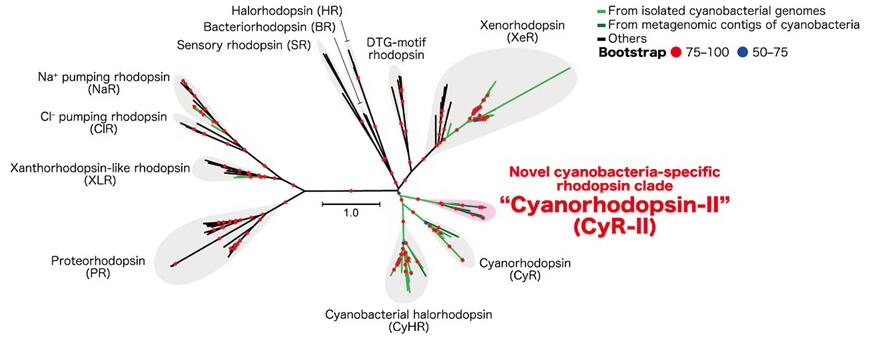A research group led by Postdoctoral Researcher Masumi Hasegawa, Institute for Extra-Cutting-Edge Science and Technology Avant-Garde Research, Japan Agency for Marine-Earth Science and Technology (JAMSTEC), and Researcher Yosuke Nishimura and Project Researcher Yu Nakajima, Research Center for Bioscience and Nanoscience, JAMSTEC, in collaboration with the University of Tokyo, RIKEN, and Okayama University, has announced that they discovered a new group of microbial rhodopsins as a light-utilizing system different from photosynthesis, from cyanobacteria known to be the oldest photosynthetic organisms, and named the group "cyanorhodopsin-II (CyR-II)." The findings indicate the possibility that cyanobacteria have evolved to adapt to various light environments through the acquisition of rhodopsins. The results were published in the international journal The ISME Journal on November 1.

Provided by JAMSTEC
In the oceans and other aquatic environments, cyanobacteria and algae, which use chlorophyll-based systems for photosynthesis, integrate light energy from the sun into the ecosystems and produce organic matter. Meanwhile, "microbial rhodopsins" have been discovered in the 2000s as a light-utilizing system completely different from photosynthesis. Rhodopsins have long been thought to be a light energy-utilizing mechanism specific to non-photosynthetic, heterotrophic microorganisms. Rhodopsin genes have also been found in cyanobacteria and algae, indicating that light utilization by microorganisms is more diverse than previously thought. However, large-scale studies on rhodopsin gene diversity in cyanobacteria have not been conducted.
Previously, the research group reported that most cyanobacteria with rhodopsin genes inhabit freshwater environments and that some CyRs are present only in cyanobacteria. CyRs produce chemical energy by releasing intracellular hydrogen ions to the outside of cells using light energy and green light, which is not used in photosynthesis. Cyanobacteria with CyR are thought to use both photosynthesis and rhodopsins.
In this study, they searched for rhodopsin genes possessed by cyanobacteria from metagenomic information obtained in various environments. As a result, they discovered the new cyanobacteria-specific rhodopsin group "CyR-II." Functional characterization revealed two subgroups of "CyR-II," one using green light and the other using yellow light.
Analysis of the protein structure to identify the cause of the difference in the color of the light used showed that the difference was due to slight structural differences around the retinal chromophore (a form of vitamin A: Upon absorption of light, it undergoes isomerization and transmits a signal according to its changes) bound in rhodopsin.
The color of light used is closely related to the environment in the habitat of cyanobacteria with "CyR-II." The green light-using "CyR-II" subgroup is found in mangroves and coastal bacterial mats and biofilms, while the yellow light-using "CyR -II" subgroup is distributed in sediment and soil environments. This suggests that cyanobacteria have adapted to their respective light environments. Furthermore, cyanobacteria were shown to have acquired various rhodopsins other than "CyR-II" through horizontal gene transfer during evolution.
Hasegawa said, "It is common knowledge that 'cyanobacteria perform photosynthesis,' and it is written even in biology textbooks. In this study, we combined genetic information analysis, molecular biology, spectroscopy, and structural biology to show that 'cyanobacteria have adapted to various light environments by utilizing not only photosynthesis but "also" rhodopsins.' Moving forward, we are going to pursue physiological analysis to clarify the intracellular role of rhodopsins in cyanobacteria."
Journal Information
Publication: The ISME Journal
Title: Cyanorhodopsin-II represents a yellow-absorbing proton-pumping rhodopsin clade within cyanobacteria
DOI: 10.1093/ismejo/wrae175
This article has been translated by JST with permission from The Science News Ltd. (https://sci-news.co.jp/). Unauthorized reproduction of the article and photographs is prohibited.




